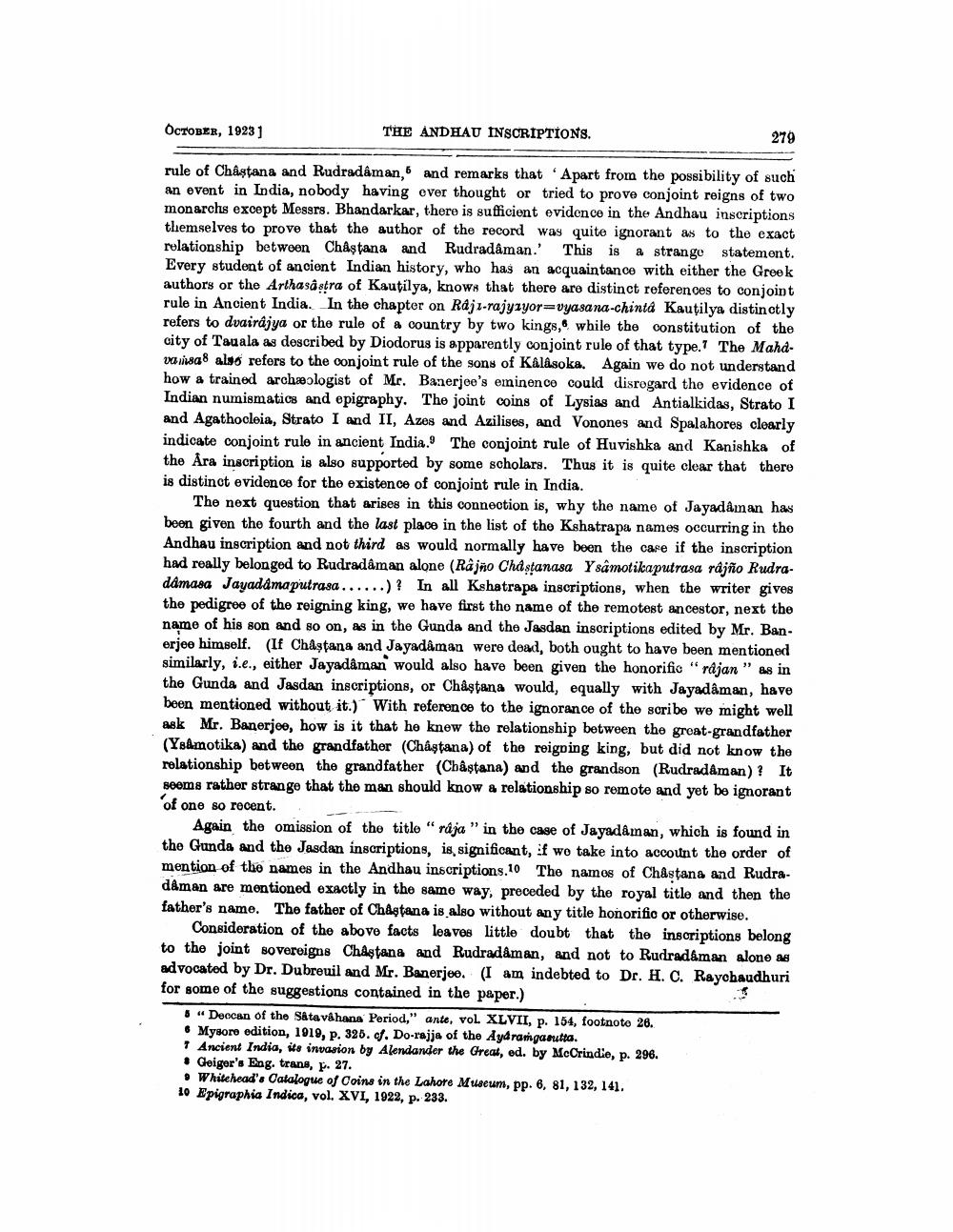________________
OCTOBER, 1923]
rule of Châstana and Rudradâman, and remarks that Apart from the possibility of such an event in India, nobody having ever thought or tried to prove conjoint reigns of two monarchs except Messrs. Bhandarkar, there is sufficient evidence in the Andhau inscriptions themselves to prove that the author of the record was quite ignorant as to the exact relationship between Châṣṭana and Rudradâman.' This is a strange statement. Every student of ancient Indian history, who has an acquaintance with either the Greek authors or the Arthasâstra of Kautilya, knows that there are distinct references to conjoint rule in Ancient India. In the chapter on Raja-rajyayor=vyasana-chinta Kautilya distinctly refers to dvairâjya or the rule of a country by two kings, while the constitution of the city of Tauala as described by Diodorus is apparently conjoint rule of that type. The Mahdvasas also refers to the conjoint rule of the sons of Kâlâsoka. Again we do not understand how a trained archaeologist of Mr. Banerjee's eminence could disregard the evidence of Indian numismatics and epigraphy. The joint coins of Lysias and Antialkidas, Strato I and Agathocleia, Strato I and II, Azes and Azilises, and Vonones and Spalahores clearly indicate conjoint rule in ancient India. The conjoint rule of Huvishka and Kanishka of the Ara inscription is also supported by some scholars. Thus it is quite clear that there is distinct evidence for the existence of conjoint rule in India.
The next question that arises in this connection is, why the name of Jayadaman has been given the fourth and the last place in the list of the Kshatrapa names occurring in the Andhau inscription and not third as would normally have been the case if the inscription had really belonged to Rudradâman alone (Rajno Châṣṭanasa Ysâmotikaputrasa rájño Rudradamasa Jayadamaputrasa......)? In all Kshatrapa inscriptions, when the writer gives the pedigree of the reigning king, we have first the name of the remotest ancestor, next the name of his son and so on, as in the Gunda and the Jasdan inscriptions edited by Mr. Banerjee himself. (If Châstana and Jayadâman were dead, both ought to have been mentioned similarly, i.e., either Jayadâman would also have been given the honorific "rajan" as in the Gunda and Jasdan inscriptions, or Châstana would, equally with Jayadâman, have been mentioned without it.) With reference to the ignorance of the scribe we might well ask Mr. Banerjee, how is it that he knew the relationship between the great-grandfather (Ysamotika) and the grandfather (Châstana) of the reigning king, but did not know the relationship between the grandfather (Châstana) and the grandson (Rudradaman)? It seems rather strange that the man should know a relationship so remote and yet be ignorant of one so recent.
THE ANDHAU INSCRIPTIONS.
5
4
279
Again the omission of the title "rája" in the case of Jayadaman, which is found in the Gunda and the Jasdan inscriptions, is, significant, if we take into account the order of mention of the names in the Andhau inscriptions.10 The names of Châṣṭana and Rudradâman are mentioned exactly in the same way, preceded by the royal title and then the father's name. The father of Châstana is also without any title honorific or otherwise.
Consideration of the above facts leaves little doubt that the inscriptions belong to the joint sovereigns Chastana and Rudradâman, and not to Rudradâman alone as advocated by Dr. Dubreuil and Mr. Banerjee. (I am indebted to Dr. H. C. Raychaudhuri for some of the suggestions contained in the paper.)
5 "Deccan of the Satavahana Period," ante, vol. XLVII, p. 154, footnote 26. Mysore edition, 1919, p. 325. cf. Do-rajja of the Aydramgasutta.
7 Ancient India, its invasion by Alendander the Great, ed. by McCrindie, p. 296. Geiger's Eng. trans, p. 27.
• Whitehead's Catalogue of Coins in the Lahore Museum, pp. 6, 81, 132, 141.
10 Epigraphia Indica, vol. XVI, 1922, p. 233.




